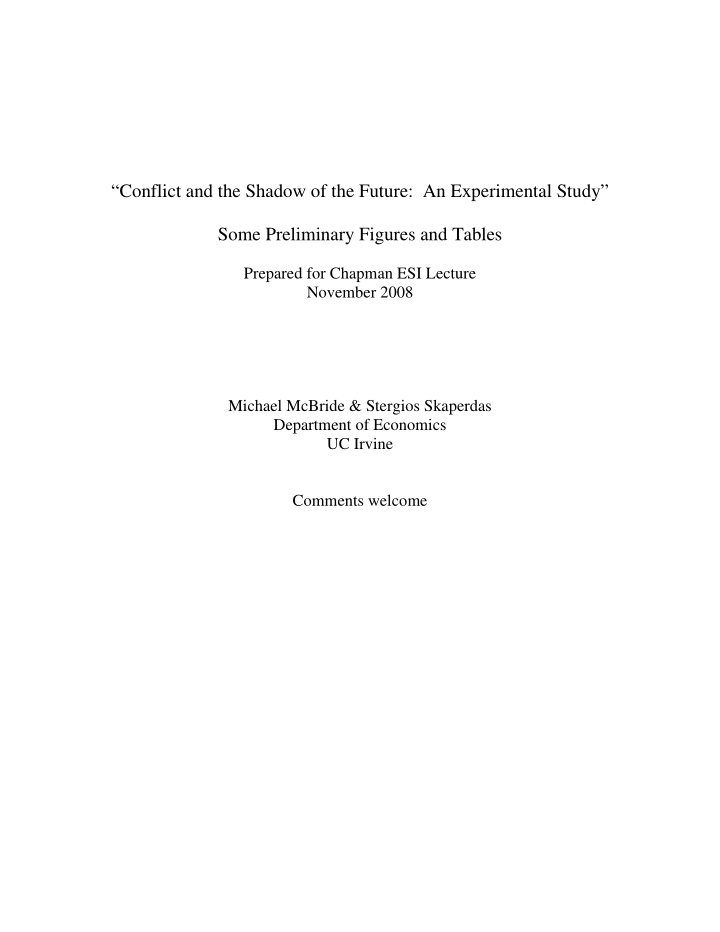



“Conflict and the Shadow of the Future: An Experimental Study” Some Preliminary Figures and Tables Prepared for Chapman ESI Lecture November 2008 Michael McBride & Stergios Skaperdas Department of Economics UC Irvine Comments welcome
Table 1: Session Information Direction of change in Exchange Pct. with 1+ Pct. with 1+ Average Number of Number of continuation rate (points/ economics statistics take-home Date subjects matches probability dollar) courses* courses* earnings** Overall -- 72 -- -- -- 46% 67% $30 Session 1 24-Sep-2008 24 12 Increase 40 54% 71% $30 Session 2 9-Oct-2008 24 12 Decrease 40 42% 79% $30 Session 3 30-Oct-2008 24 24 Increase-decrease 80 42% 50% $34 Session 3(a) 30-Oct-2008 24*** 12 Increase 40 -- -- -- Session 3(b) 30-Oct-2008 24*** 12 Decrease 40 -- -- -- Notes: Sessions 3(a) and 3(b) comprise the first and second halves of Session 3, respectively; i.e., the subjects in Sessions 3(a) and 3(b) (***) are the same subjects listed for Session 3. Information on courses (*) is obtained from subject questionnaires. This average take-home earnings (**) reporrted do not account for round-offs made before paying subjects, but reported earnings do include initial amounts given to prevent bankruptcy. Subjects in Sessions 1 and 2 were given an initial amount of $6, and subjects in Session 3 were given an initial amount of $3 in each half.
Table 2: Percent Flips by Continuation Probability, Overall and by Session Continuation Probability 0 0.5 0.75 Overall 27% 63% 66% Obs. 384 384 384 Session 1 22% 51% 73% Obs. 96 96 96 Session 2 35% 59% 57% Obs. 96 96 96 Session 3 26% 71% 68% Obs. 192 192 192 Session 3(a) 22% 71% 65% Obs. 96 96 96 Session 3(b) 29% 71% 71% Obs. 96 96 96 Notes: The overall average uses all data from Sessions 1, 2, and 3. Sessions 3(a) and 3(b) comprise the first and second halves of Session 3, respectively.
Figure 1(a): Percent Flips by Match, Session 1 100% p=0.75 80% p=0.5 60% Pct Flips 40% 20% p=0 0% 1 2 3 4 5 6 7 8 9 10 11 12 13 14 15 16 17 18 19 20 21 22 23 24 Match Figure 1(b): Percent Flips by Match, Session 2 100% 80% p=0.75 p=0.5 60% Pct Flips 40% p=0 20% 0% 1 2 3 4 5 6 7 8 9 10 11 12 13 14 15 16 17 18 19 20 21 22 23 24 Match Figure 1(c): Percent Flips by Match, Session 3 100% p=0.5 p=0.75 p=0.75 p=0.5 80% 60% Pct Flips p=0 p=0 40% 20% 0% 1 2 3 4 5 6 7 8 9 10 11 12 13 14 15 16 17 18 19 20 21 22 23 24 Match
Table 3: Percent Outcomes by Continuation Probability, Overall and by Session Continuation Probability 0 0.5 0.75 Overall Flip-flip 5% 39% 41% Flip-split 45% 49% 51% Split-split 51% 13% 8% Session 1 Flip-flip 0% 23% 52% Flip-split 44% 56% 42% Split-split 56% 21% 6% Session 2 Flip-flip 8% 31% 27% Flip-split 54% 56% 60% Split-split 38% 13% 13% Session 3 Flip-flip 5% 50% 43% Flip-split 41% 42% 50% Split-split 54% 8% 7% Session 3(a) Flip-flip 4% 52% 40% Flip-split 35% 38% 50% Split-split 60% 10% 10% Session 3(b) Flip-flip 6% 48% 46% Flip-split 46% 46% 50% Split-split 48% 6% 4% Notes: The overall average uses all data from Sessions 1, 2, and 3. Sessions 3(a) and 3(b) comprise the first and second halves of Session 3, respectively. Averages may not sum to 100 due to round-off error.
Table 4: Number of Subjects by Choice Classification, Overall and by Session Choice Classification (1) (2) (3) (4) (5) (6) (7) (8) (9) (10) Flips0.75 ≥ Flips0.5 ≥ Flips0 ≥ Flips0 ≥ Flips0 = Flips0 = 0 < Flips0 Flips0.75 ≥ Flips0 ≥ Flips0.5 ≥ Flips0 ≥ Flips0.75 ≥ Flips0.5 ≥ Flips0.5 = Flips0.5 = = Flips0.5 Flips0.5 ≥ Flips0.5 Flips0.75 ≥ Flips0.75 Flips0.5 Flips0.75 Flips0.75 = Flips0.75 = = Flips0.75 Flips0 (not (not all Flips0 (not (not all (not all (not all all 0 < All all equal) equal) all equal) equal) equal) equal) Total Overall 3 5 1 40 7 7 5 2 2 70 Session 1 1 3 1 15 2 1 1 0 0 24 Session 2 2 2 0 11 2 2 3 2 0 24 Session 3 0 0 0 14 3 4 1 2 0 24 Session 3(a) 0 0 0 16 0 4 2 1 1 24 Session 3(b) 1 2 0 13 1 2 1 3 1 24 Overall using 4 7 1 55 5 9 7 6 2 96 3(a) and 3(b)* Notes: The overall total uses all data from Sessions 1, 2, and 3. Sessions 3(a) and 3(b) comprise the first and second halves of Session 3, respectively. Column (4) best matches the predicted behavior of expected payoff maximization. The overall total (*) that uses 3(a) and 3(b) treats the subjects in Session 3 as if they are different persons in 3(a) than in 3(b).
Recommend
More recommend